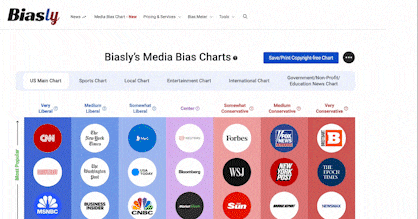
The Houston Chronicle is a reputable news source with a long history of comprehensive coverage of local, national, and international events. As one of the largest newspapers in Texas, it is well-known for its investigative journalism and in-depth reporting. According to Statista, as of 2024, it ranks as the ninth most-read daily newspaper in the United States. However, the Houston Chronicle has faced controversy regarding its journalistic integrity. In 2018, the publication retracted eight articles and corrected 64 others after finding that many sources cited were unverifiable. At Biasly, we aim to assess the accuracy and reliability of all media outlets. Let us investigate the reliability and accuracy of the Houston Chronicle.
Does Reliability Matter?
Reliability, in general, refers to how trustworthy or accurate information, or in this case, a news source is. If we consider this definition, it quickly becomes clear why reliability is important in media sources. If we can’t trust the things we read then there isn’t much of a point in continuing to consume content from that source, after all. So how exactly can we gauge the reliability of a news source anyways?
There are several potential measures of reliability to look out for when trying to determine whether a media source is reliable or not. Red flags for an unreliable article can include the presence of wild unsubstantiated claims, facts dependent on other unreliable sources, heavy use of opinionated language, and more. Some indicators of a reliable news source, on the other hand, include things like:
- Absence of subjective/opinionated language in articles
- Credible sources cited (e.g., neutral sources, .gov, .edu websites)
- Facts and statistics backed by multiple relevant outside sources
- Use of primary sources when possible (e.g., interviews, quotes)
- Information that remains consistent across news sources
How Does The Houston Chronicle Fare in its Reliability?
The political reliability index developed by Biasly objectively assessed news organizations’ accuracy and trustworthiness. Houston Chronicle’s overall Reliability Score has been rated as ‘Fair’ by Biasly. This rating is a weighted average of two distinct scores: the Fact Analysis Score and the Source Analysis Score, each evaluating separate components of Houston Chronicle’s Reliability.
When computing the Average Reliability of the article, the Fact Analysis score is more heavily weighted. These ratings are as follows in the next two paragraphs:
Houston Chronicle’s Fact Analysis Score is ‘N/A’, as Biasly’s analysts have not rated the facts in the news source to this point other than what is found in this article in lower sections.
Houston Chronicle’s Source Analysis Score is ‘Fair,’ which suggests readers can trust some of the sources, links, and quotes provided by the news source. This score, which is based on A.I., focuses on assessing the quality of sources and quotes used, including their number, lengths, uniqueness, and diversity.
However, since these scores are based on percentages and averages, individual articles could be more or less trustworthy depending on the context, author, and other factors. Our findings show that The Houston Chronicle’s reliability is mostly but not all factual because it has retracted several stories in the past and published articles with unverified sources.
Let us analyze the supporting data for the Houston Chronicle’s rankings and discuss what to watch out for while searching for trustworthy news sources.
Houston Chronicle’s Accuracy and Reliability
The Houston Chronicle is known for its centralized reporting but has a history of using unverifiable sources. At Biasly, we will evaluate the credibility of the Houston Chronicle’s news stories by examining the quality of the sources used, the accuracy of the reporting, and any potential bias in the articles.
Selection bias is when stories and facts are selected or deselected, often on ideological grounds, to create a narrative supporting the new sources’ ideology. Omission bias, on the other hand, is when different opinions and political views regarding a situation are left out so that the reader is only exposed to the ideological perspective supported by the author. It’s essential to keep in mind these two types of biases when trying to assess an article’s level of accuracy.
Biasly assigns a percentage score to accuracy, with one being the least accurate and 100 being the most. Ratings are calculated by weighing assertions with supporting evidence, the number of reliable internal sources, and the number of reliable external sources employed. A full page at Biasly’s website includes dependability and accuracy ratings for newly released Buzzfeed news stories. According to the reports that analytics have assessed, the Houston Chronicle has a ‘Fair’ reliability score. This score can vary from article to article, though, and the most extreme variations in dependability are caused by bias, notably omission and selection bias.
We will examine more examples to investigate the reliability of articles from the Houston Chronicle. This analysis will focus on selection bias, omission bias, and the quality of the sources and facts presented.
Analysis of Reliability in Houston Chronicle Online Pieces
The Houston Chronicle online articles typically feature a straightforward and informative style aimed at delivering news clearly and concisely. The Opinion section of the Houston Chronicle includes a variety of viewpoints that may not always align with the paper’s overall stance. This section allows columnists and guest contributors with specific ideological leanings to express their views and engage in subjective analysis openly.
Because the Houston Chronicle has an Opinion section, its content is diversified, enabling its readers to understand complex issues better. Opinion articles can offer diverse and valuable insights on complex matters, contribute to polarization, and reinforce existing biases. With its impartiality, it is vital to stay vigilant when analyzing its articles, observing selection and omission biases to see what information they choose to include or exempt.
Quality of Sources and Facts Used
The Houston Chronicle has faced controversy over publishing articles that rely on unconfirmed sources. Such sources can significantly undermine a publication’s credibility, as they may spread false or misleading information.
Take, for example, “Fact check: J.D. Vance says Tim Walz left the military when asked to go to Iraq.” by Sara Swann. This article received an “Excellent” rating for its Source Analysis and Multiple Source Rating, with 95% and 100%, respectively. Author Sara Swann incorporates 16 quotes of varying lengths: nine are short, five are medium, and two are long.
Additionally, 8 out of the 16 unique sources Swann uses in her articles originate from:
- Army Lt. Col. Ryan Rossman, Minnesota National Guard’s director of operations
- Army Lt. Col. Kristen Augé, Minnesota National Guard’s state public affairs officer
- D. Vance
- Joseph Eustice, a 32-year military veteran
- The National Guard Public Affairs Office
- NY TIMES (Medium Liberal)
- FOX NEWS (Medium Conservative)
- WASHINGTON POST (Somewhat Liberal)
Sara Swann adopts a balanced approach in her use of sources, drawing information from both liberal and conservative outlets, such as the New York Times and Fox News. This demonstrates her effort to provide a well-rounded perspective while avoiding bias towards either side of the political spectrum. By incorporating insights from various sources, including military officials and public affairs offices, Swann aims for a neutral and objective presentation of facts.
In contrast, James Osborne’s article “Texas Sees 6% Increase in Clean Energy Jobs, Among Largest in U.S.” has an astonishing 40% rating for “Fair” Source Analysis. However, its Multiple Sources rating is “Good” at 75%. Notably, the article cites only one unique source: the Houston Chronicle. Therefore, to score higher on articles, news sources should include more external sources on both sides of the aisle and longer and more quotes from primary sources.
Swann’s article showcases various sources, including military personnel and multiple media outlets with different political affiliations, ensuring a well-rounded and credible perspective. In contrast, Osborne’s article relies heavily on a single source, the Houston Chronicle, lacking the same level of source diversity. This stark difference highlights the importance of incorporating multiple, varied sources to enhance the credibility and depth of journalistic work.
Selection and Omission Bias
As stated before, the Houston Chronicle is considered a centralist publication that does not lean toward any political ideology nor have a specific agenda to promote its audience in a particular direction. Opinion articles can offer personal viewpoints on various topics, allowing writers to express their perspectives. Biased articles present information with a slant that unfairly favors a particular side or agenda, potentially misleading readers and shaping their views without sending a balanced view.
Let us examine an opinion article from The Editorial Board, “Catholic bishops should leave politics to politicians and tread carefully on communion question,” which is centralist-leaning. The article discusses whether politicians like Biden, who support women’s reproductive rights, should be excluded from practicing their faith.
The sources used in the article include historic speeches by Senator John F. Kennedy, surveys by the Pew Research Center, and statements from individual bishops such as Bishop McElroy of Diego and the views of Pope Francis and the Vatican. The article presents the historical context of the separation of the church and state, the potential implications of the bishops’ decision, and the opinions of the Houston Chronicle Editorial Board.

Source: Pew Research Center
“I believe in an America where the separation of church and state is absolute, where no Catholic prelate should tell the president, should he be Catholic, how to act and no Protestant minister would tell his parishioners how to vote,” Kennedy told the Greater Houston Ministerial Association Sept. 12.”
“The Eucharist must never be instrumentalized for a political end, no matter how important,” said Bishop Robert McElroy of San Diego urged his fellow bishops ahead of the June meeting.”
“If the bishops are going to begin excluding politicians from communion on the basis of just one of those morale crusades, they will soon find themselves accused of cherry-picking priorities, not out of a sense of religious duty, but out of loyalty to an unholy partisan agenda.”
The article emphasizes the potential negative consequences of the bishops’ actions, such as “cherry-picking priorities” and intervening in politics. This bias may lead readers to view the bishops’ actions in a negative light and sympathize with President Biden’s position. Additionally, it limits the representation of the bishops’ perspective and the lack of exploration and reasoning for considering a religious restriction on communion for pro-choice politicians. The article may influence readers to align with the viewpoint of the Houston Chronicle Editorial Board and perceive the bishops’ actions as politically motivated and potentially harmful without fully considering the theological and doctrinal aspects of the issues.
So, Is The Houston Chronicle Reliable?
The Houston Chronicle is a reliable news source because of its centrist approach and commitment to impartiality. While all media—whether physical or digital—contains some form of bias, this should not prevent you from trusting other news sources. Instead, it is essential to evaluate publications based on their sources, coverage choices, omissions, and factual accuracy to determine if an article may have any potential bias. To help with this, you can use Biasly’s News Bias and Reliability Checker to assess the reliability and credibility of your news sources.























